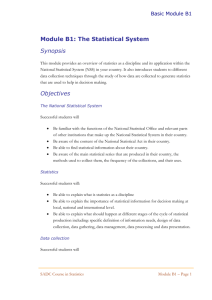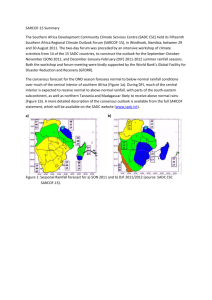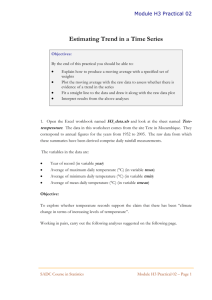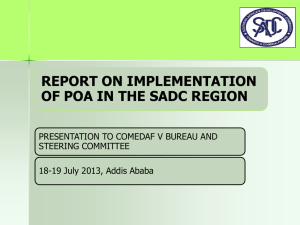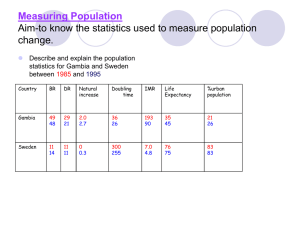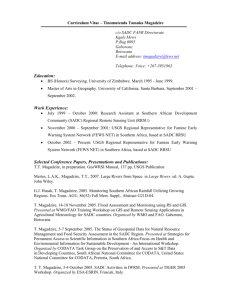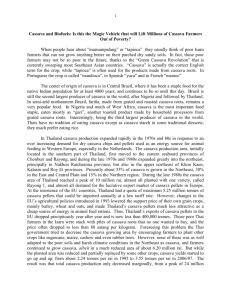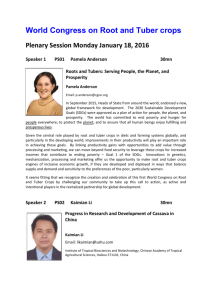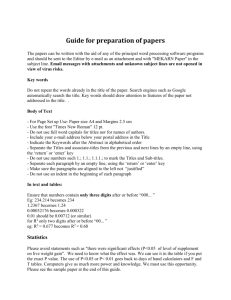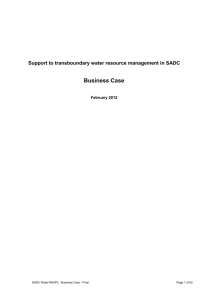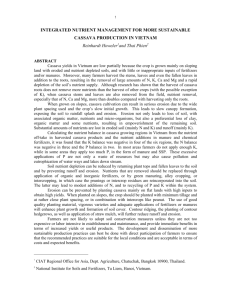Choosing appropriate methods for data collection
advertisement
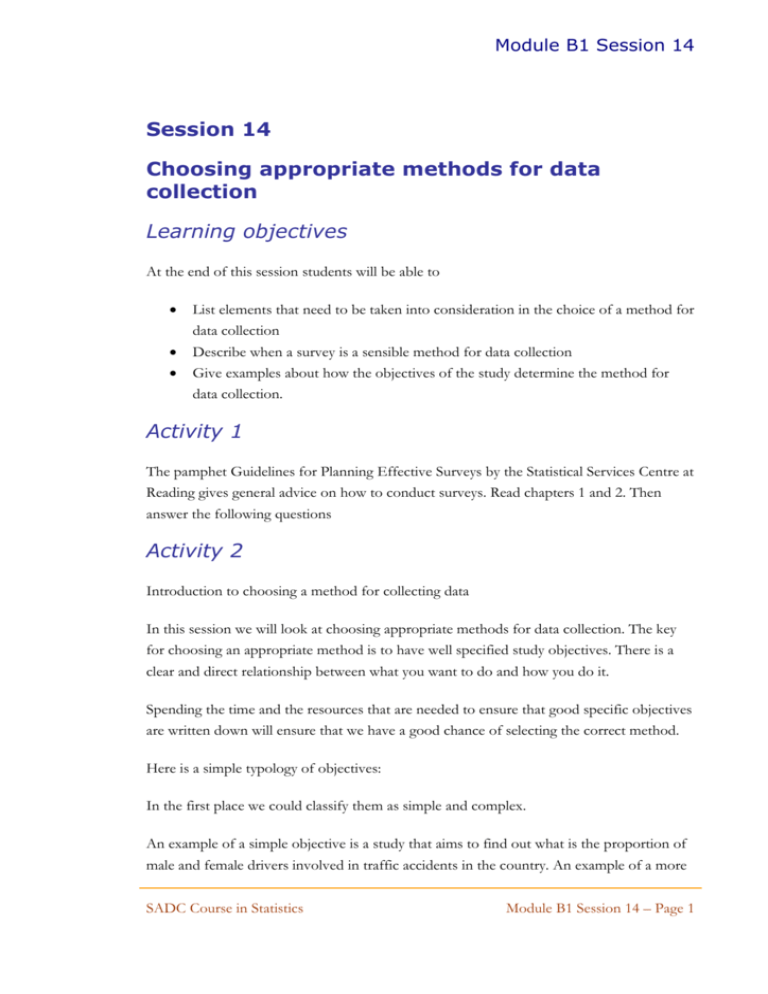
Module B1 Session 14 Session 14 Choosing appropriate methods for data collection Learning objectives At the end of this session students will be able to List elements that need to be taken into consideration in the choice of a method for data collection Describe when a survey is a sensible method for data collection Give examples about how the objectives of the study determine the method for data collection. Activity 1 The pamphet Guidelines for Planning Effective Surveys by the Statistical Services Centre at Reading gives general advice on how to conduct surveys. Read chapters 1 and 2. Then answer the following questions Activity 2 Introduction to choosing a method for collecting data In this session we will look at choosing appropriate methods for data collection. The key for choosing an appropriate method is to have well specified study objectives. There is a clear and direct relationship between what you want to do and how you do it. Spending the time and the resources that are needed to ensure that good specific objectives are written down will ensure that we have a good chance of selecting the correct method. Here is a simple typology of objectives: In the first place we could classify them as simple and complex. An example of a simple objective is a study that aims to find out what is the proportion of male and female drivers involved in traffic accidents in the country. An example of a more SADC Course in Statistics Module B1 Session 14 – Page 1 Module B1 Session 14 complex objective would be if an HIV/AIDS awareness programme is concerned about the cultural acceptability of a series of messages that have been broadcasted to the rural population of a SADC country. How they are received by people of different ages and sex? And what information is perceived as important in rural communities? In these two examples, for the first study objective a simple method of data collection, such as a review of records kept by traffic policy would probably work – in their absence a more complex method would have to be devised. In the second case, given that we are talking about perceptions, levels of acceptability of issues that people will find either difficult or complex to discuss, might require a method of data collection that is more qualitative than a simple inspection of records. The next way in which we could classify objectives is those that have to do with factual information and those that have to do with subjective information. An example of the first case is a study that aims to find out what is the number of people that live in an area? This factual information should be easy to obtain if we agree of counting anyone who slept in the dwellings in the area in the night prior to the data collection day. This is similar to a question that a population census would ask. It is factual because it is possible to ascertain with a high level of accuracy the number of people that slept in the dwellings of the area, provided that the definition of dwelling is unambiguous. An example of subjective information would be a study that aims to find out whether communities consider that a method of targeting food aid, based on the perceived poverty level of a household, is fair? Here we are dealing with a difficult concept, that is, the concept of fairness. We are also dealing with the perception of fairness among groups of households. This is particularly difficult if in a community some people would receive food aid and some people would not. So, how do you go about finding out whether the community as a whole think that the distribution is fair? It is likely that those who did not receive the benefit would say that it was unfair and vice versa. This does not mean that as a community they would consider that the distribution was done in a fair manner. Another possible classification of objectives is into: easy measure or difficult to measure. Let me give you an example of each of those. An easy to measure example is a study that aims to find out what is weight to height ratio of children older than 5 years in a SADC Course in Statistics Module B1 Session 14 – Page 2 Module B1 Session 14 community? It should be possible and is relatively easy to measure the weight and height of the children in each selected households. One that is slightly more difficult to measure is what is the total production of cassava by smallholder households in your country? Those of you who have experience in harvesting cassava or trying to measure cassava production at smallholder level would be aware that in general the product is harvested when needed for sale or consumption. It is very difficult to have an accurate measure of how much is still to be harvested because the part of the plant that we are interested in is below ground. If the objective is extended to finding out what is the expected contribution cassava production by smallholders to the food security of the country the difficulties increase. In order to assess this we would need to have reliable estimates of future production and we would need to be able to convert them into national estimates. If our estimates at household level are poor, the information that will be generated for the whole country will compound the problems and the estimates are likely to provide weak evidence. The fact is that in choosing a method for collecting this information we need to be very careful and probably this would involve not a questionnaire survey, not a census, not an in-depth qualitative study, but a methodology that is able to record the production of cassava over a period of time. The challenges here will be bigger than in many of the previous cases. Another classification would be whether the objectives of your study have to do with estimation or comparison. Estimation refers to process of inferring from the results of a sample the value for a whole population, the population from which we took the sample. In the case of comparison what we are trying to do is not so much to estimate the value in the whole population but the difference in the values in specific groups of the population. Let me give you two examples: In the case of estimation it would not be surprising that at some point the NSO conducts a study to estimate the total number of adults who have a mobile phone in the country. In the case of comparison we could cite the case of a study that aims to establish whether the distribution of treated mosquito nets reduces the incidence of malaria in a district. This is a comparison that by definition is talking about the period before and the period after the distribution of mosquito nets. This has important implications for the choice of the data collection method and the design of the overall study because we need measurements SADC Course in Statistics Module B1 Session 14 – Page 3 Module B1 Session 14 before the distribution, measurements after the distribution. Furthermore, we need to isolate all the factors that may have reduced the incidence of malaria such as seasonality. Another possible classification is whether the researcher or the institution conducting the study needs to have control over the conditions in which the study is carried out or whether such control is not needed. An example of having control could be if we need to answer the question: Can we prove that the introduction of supplementary feeding at primary schools has a beneficial impact on the school performance of the children? I would argue that we need certain level of control in order to achieve this objective because we need to have an idea of what the school performance is with and without the supplementary feeding. A good answer will only be possible if we are able to impose conditions in some schools where the supplementary feeding is distributed and some schools where it is not. Of course in designing this study we would need to make sure that ethical considerations play an important role. This objective leads to the implementation of an experiment. An example where we do not need control is if we need to find out what percentage of children that start primary school complete it. In this case we will only need to observe and record the number of children that start and the number of children that complete the process and would require examination of administrative records. This is a simple and incomplete typology and you would have noticed that an objective does not fall into only one category, but it may be described as fitting into many of these types. Having a clear and specific idea about what we want to find out helps in choosing a method data collection. Another consideration to bear in mind is what the population of interest is. Without a clear and unambiguous definition of the population of interest, it is impossible to conduct a good study, and the choice of method is unlikely to be appropriate. There are some questions that would help in the process of choosing your method: How big is the population? SADC Course in Statistics Module B1 Session 14 – Page 4 Module B1 Session 14 If the population is very big, or very scattered, it is unlikely that you would be able to implement a census unless it is done at a very high cost. The most likely method of data collection will necessarily involve some level of sampling. If the population is small then probably the difference between conducting a census or a survey will not be that big in terms of the demand for resources: time, money, staff, and it would be possible to conduct a full enumeration. Sometimes even with large populations we need a full enumeration of the population and it that case the choice of a census is given by the objectives of the study. For example, we tend to plan population census once every ten years and that implies a big effort on the side of the NSO of the country. All these considerations have a bearing on important aspects of the design of the study and as an introduction to what would be discussed in other modules we list some of the key questions: • What is the definition of study units • What is the method of selection • How you organise the field work • Decisions about what to measure • The strategy for analysis of data • Duration of study • Composition of study teams • Ethical considerations The decision on the choice of method for data collection is mainly driven by the research objectives. It is a decision that needs to be made with common sense and not rigidly following prescriptions provided in text books. SADC Course in Statistics Module B1 Session 14 – Page 5

